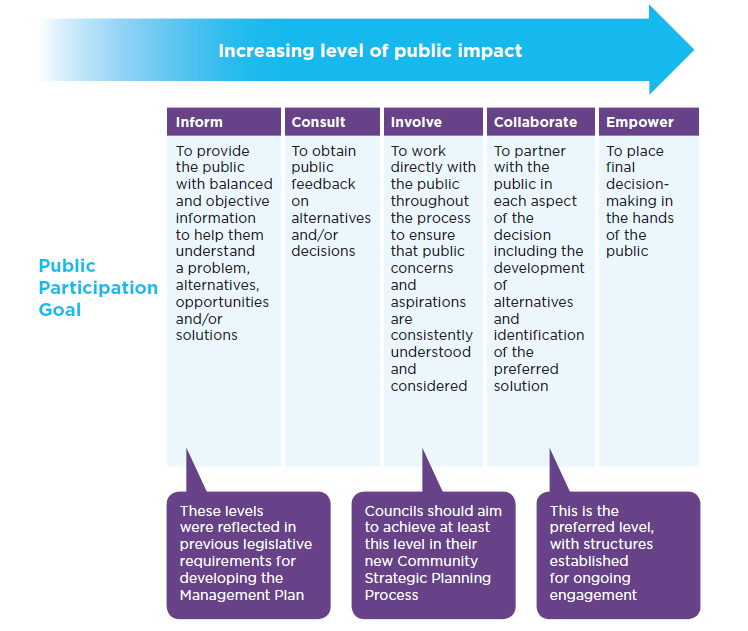The IP&R Framework is underpinned by strong community engagement. Engagement with residents as well as business, state agencies and non-government organisations is essential to creating plans that will truly represent the aspirations and needs of the local community.
Each council is required to create a strategy for how they will engage the community in creating and reviewing their Community Strategic Plan. This strategy must:
- be based on the social justice principles of access, equity, participation and rights
- identify relevant stakeholder groups in the community
- outline the methods that the council will use to engage each of these groups.
- allow sufficient time to effectively undertake the engagement
It is important to understand the difference between informing the community about what the council is proposing, and empowering the community to play an integral role in determining the goals, strategies and actions to be undertaken.
The ‘Community Strategic Plan’ chapter of the Integrated Planning and Reporting Manual for local government in NSW provides detailed information and good practice examples of community engagement.

Additional information on specific engagements
-
Engaging on council levels of service
Talking to the community about acceptable levels of service is one of the most important conversations the council will have. There are many approaches available to councils when having this conversation. Some suggested steps that the council might wish to consider include explaining:
- what services and facilities the council provides
- the current condition of these services and facilities
- the cost associated to bring these to a higher standard and to maintain them into the future
- any challenges facing the council in providing these services
- what options are available to the council to face these challenges.
The council may wish to ask the community to rank services and facilities in order of priority. Some councils have achieved this via a broad community survey in order to capture a good-cross section of community members. The council and community can then discuss any gaps between the importance of the service/facility and the community’s expectations of that service/facility and its satisfaction with it.
When looking at how the gaps can be reduced, the council might consider forming a community focus group to look at the issues and options in detail. The group will need to consider things like the possibility of enhancing, reducing, replacing or maintaining the council’s asset portfolio and funding sources. This discussion will need to be held within the context of the Community Strategic Plan and Delivery Program, and the current aspirations or goals the community has already identified.
-
What is meant by 'service levels'?
One of the most important discussions a council will have with its community during the planning process is in regard to expected levels of service. Many councils find it challenging to meet the increasing expectations of their community – particularly in rural areas where changing demographics may bring different expectations regarding service standards.
Although it may be difficult to gain consensus on levels of service, it is helpful to hold these discussions with the community. What do people really expect in terms of rural roads or street cleaning or recreational facilities? Are they willing to meet the cost of increasing expectations? Can they identify priorities in service provision? Are there services which could be delivered more effectively or efficiently by the council? The Asset Management section contains further information on determining service levels specifically in relation to assets.
Ideally, the conversation with the community about levels of service should be treated as an ongoing one. However, it’s important to ensure it is incorporated as part of the community engagement that informs the development of the Community Strategic Plan and the Long-Term Financial Plan.
Levels of service are explained as “…defined service quality for an activity or service area (for example, the road network) against which service performance may be measured”. Levels of service are determined through community or customer consultation, and consider:
- quality
- quantity
- safety
- capacity
- fitness for purpose
- aesthetics
- reliability
- responsiveness
- environmental acceptability
- costs.
The impact of changes in demand over time on service levels should be regularly established and accounted for. This will provide a clear understanding of cost implications across the whole lifecycle of the service.
-
Community engagement for a special rate variation (SRV)
A local council might determine that a special rate variation is the most appropriate way to fund the Delivery Program commitments in order to achieve community outcomes. In applying for a special rate variation, the council will need to demonstrate how it’s Community Strategic Plan and Delivery Program support and justify this option. In short, the council should have:
- modelled the special rate variation as one of the scenarios in the Long-Term Financial Plan to demonstrate what would be achieved by the rate variation
- held discussions with the community about service levels and funding priorities and, with the community, determined that a rate variation is the best way to achieve financial sustainability
- documented the proposed rate variation in its Integrated Planning and Reporting documents to demonstrate how the income would achieve its Delivery Program commitments and enhance community outcomes.
- documented the community engagement process and its outcomes which informed the council’s decision to proceed with a rate variation application to the Independent Pricing and Regulatory Tribunal (IPART).
